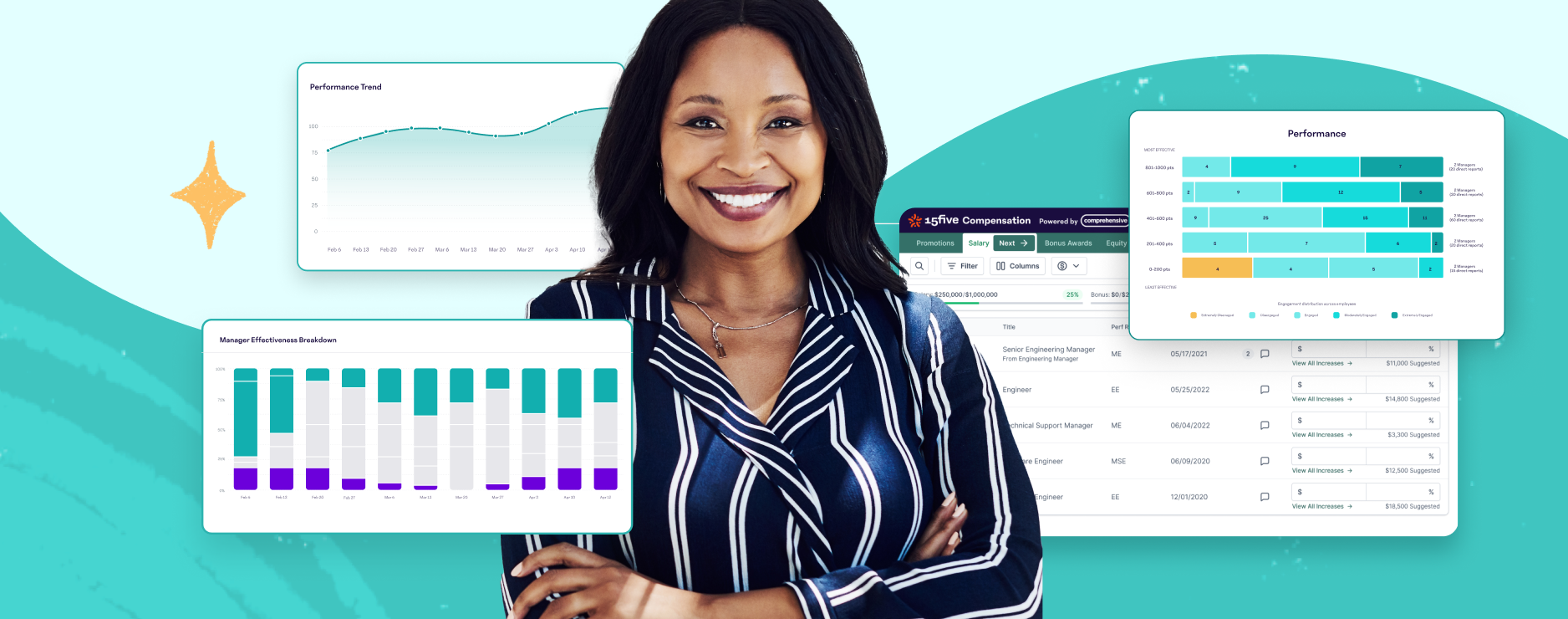Top 7 Employee Engagement Goals for HR Professionals
Businesses with engaged employees have lower rates of absenteeism and turnover, higher customer loyalty, and increased profitability.
Considering these benefits, you’d think driving employee engagement would be a top priority at every organization. But the numbers tell a different story.
Gallup’s State of the Global Workplace: 2023 Report found that only 23% of employees worldwide and 32% in the U.S. were actually engaged at work.
So what gives?
Employee engagement is critical to a healthy business but is also consistently overlooked. In today’s environment, it’s not enough to simply state that you want to improve employee engagement. You need to set deliberate employee engagement goals.
In this article, we’ll explain why setting employee engagement goals is important and provide some examples to show you how to set goals that will actually improve engagement, affect business outcomes, and build a better workplace.
What is employee engagement?
Here’s how we at 15Five define employee engagement:
An employee’s intellectual (head) and emotional (heart) connection with an employer, demonstrated by motivation and commitment (hands) to positively impact the company vision and goals.
Engagement isn’t summed up in a series of annual survey responses. It’s not an award or rating that an outside party gives you. It’s simply the way your employees feel about your company and what it stands for — and how they demonstrate that in their daily work.
Why is employee engagement important?
By setting employee engagement goals, HR leaders can regularly review and monitor metrics to ensure their goal of increasing engagement is met.
These goals should align with business objectives. For example, if customer service is a major contributor to business success, your employee engagement goals should center around engagement specifically for customer experience reps.
Conversely, for high-growth or VC-backed companies, engagement goals may be more focused on metrics that correlate to higher profitability.
In short, employee engagement goals matter because they offer a concrete way to achieve outcomes that might otherwise go unnoticed. When they’re aligned with business goals, they benefit both employees and the business.

Types of Employee Engagement
Being “engaged” can look different from employee to employee — but in general, all employees can be categorized into one of these three types of employee engagement:
- Actively Engaged: These employees are passionate about their role and the work that they do on a daily basis, and they have a strong feeling of having an impact on the organization’s broader goals. These employees tend to spread good morale and serve as advocates for the employer brand and the overall brand.
- Not Engaged: These employees are those that are doing what is considered “the bare minimum” — they often will complete what is expected of them, but will not be proactive in going above and beyond to bring new ideas to the table or improve existing processes.
- Actively Disengaged: These employees are actively unhappy with their role, much more likely to be struggling with productivity and goal completion, and are at risk for spreading their disengagement and low morale to others on the team.
Knowing the different types of engagement on a broader level can be helpful, but it is important to know that no employee is stuck in one type of engagement permanently — an engaged employee can always become disengaged, so it’s important to work to adequately reward their efforts and keep them happy so they stay with the company. On the other hand, actively disengaged employees are not a lost cause, and it’s critical to pinpoint who this disengaged employees are so that action can be taken to both help them become more engaged and to ensure that they do not affect the engagement levels of other employees.
How to define employee engagement goals
Before you can create employee engagement goals, you need to understand your organization’s current state of engagement.
Conducting an employee engagement survey is a great first step if you haven’t already been collecting engagement data. Once you’ve established a baseline to improve upon, you can start documenting your goals.
Start by identifying strategic milestones that align with the organizational calendar where engagement can be measured. For example, if your organization sets and measures new goals or OKRs every quarter, maybe engagement can be measured on a quarterly basis as well.
Once you have a process in place for measuring employee engagement on a regular basis, you can start to set some goals for continued improvement.
7 examples of employee engagement goals
Let’s review some examples of employee engagement goals, how to articulate them, and what’s needed to set each goal effectively.
1. Establish clear communication channels
How to define this goal: “We will foster a culture of transparency and openness within the organization by providing accessible and well-defined communication channels.”
What it looks like to successfully achieve this goal:
- Clear guidelines for and channels of communication exist between leadership and employees
- Regular feedback mechanisms are in place, such as surveys, suggestion boxes, or town hall meetings
- When surveyed, employees report that they feel they can express their feedback and opinions to the right people via channels that feel accessible and appropriate
2. Promote professional development opportunities
How to define this goal: “We will support our employees’ growth and development with programs and policies that provide valuable and relevant growth opportunities.”
What it looks like to successfully achieve this goal:
- Offering training programs, workshops, or mentorship opportunities for employees
- Empowering employees to enhance their skills and advance their careers within the organization
- When surveyed, employees report that they feel there are enough opportunities available for them to grow their skills and their careers
3. Recognize and reward achievements
How to define this goal: “We will boost morale, motivation, and overall job satisfaction by providing timely and specific recognition and rewards.”
What it looks like to successfully achieve this goal:
- Setting up a Slack channel to recognize achievements and tracking engagement within the channel
- Implementing a formal recognition program to celebrate milestones and achievements
- When surveyed, employees report that they feel they are appropriately recognized and celebrated when they go above and beyond
4. Improve work-life balance
How to define this goal: “We will introduce HR policies that promote a healthy work-life balance for our employees.”
What it looks like to successfully achieve this goal:
- Providing HR guidelines and programs that promote work-life balance among employees, like a work-from-home policy, flexible work arrangements, or personal days
- Offering wellness initiatives that prioritize self-care, like a wellness spending fund
- When surveyed, employees report that they have a manageable workload, feel they can take time for themselves when they need to, and can leave work at work
5. Enhance team collaboration
How to define this goal: “We will foster a sense of belonging, camaraderie, and shared purpose among employees.”
What it looks like to successfully achieve this goal:
- Establishing goals to improve collaboration and teamwork within the organization
- Implementing team-building activities, cross-functional projects, or collaborative tools
- When surveyed, employees report that they can easily work with teams other than their own and can collaborate without barriers
6. Ensure manager support
How to define this goal: “We will ensure managers are actively engaged with and supportive of their teams.”
What it looks like to successfully achieve this goal:
- Providing leadership training, coaching, or feedback mechanisms for managers
- Encouraging strong leadership and positive manager-employee relationships
- When surveyed, employees report that they feel supported by their managers and that their manager truly cares
7. Monitor and measure progress
How to define this goal: “We will regularly monitor and measure employee engagement metrics.”
What it looks like to successfully achieve this goal:
- Using data analytics, surveys, or performance reviews to track progress
- Regularly identifying areas for improvement and adjusting strategies accordingly

Employee engagement goals benefit everyone
With the right goals, you can take employee engagement from a hard-to-define intention to a measurable, concrete part of the business that can be effectively quantified and improved upon.
When you set these goals, you’ll improve employee engagement and ensure business success—lowering turnover, improving satisfaction, and ultimately improving the bottom line.
If you’d like to learn more about employee engagement goals, try 15Five for free or schedule a demo today.




